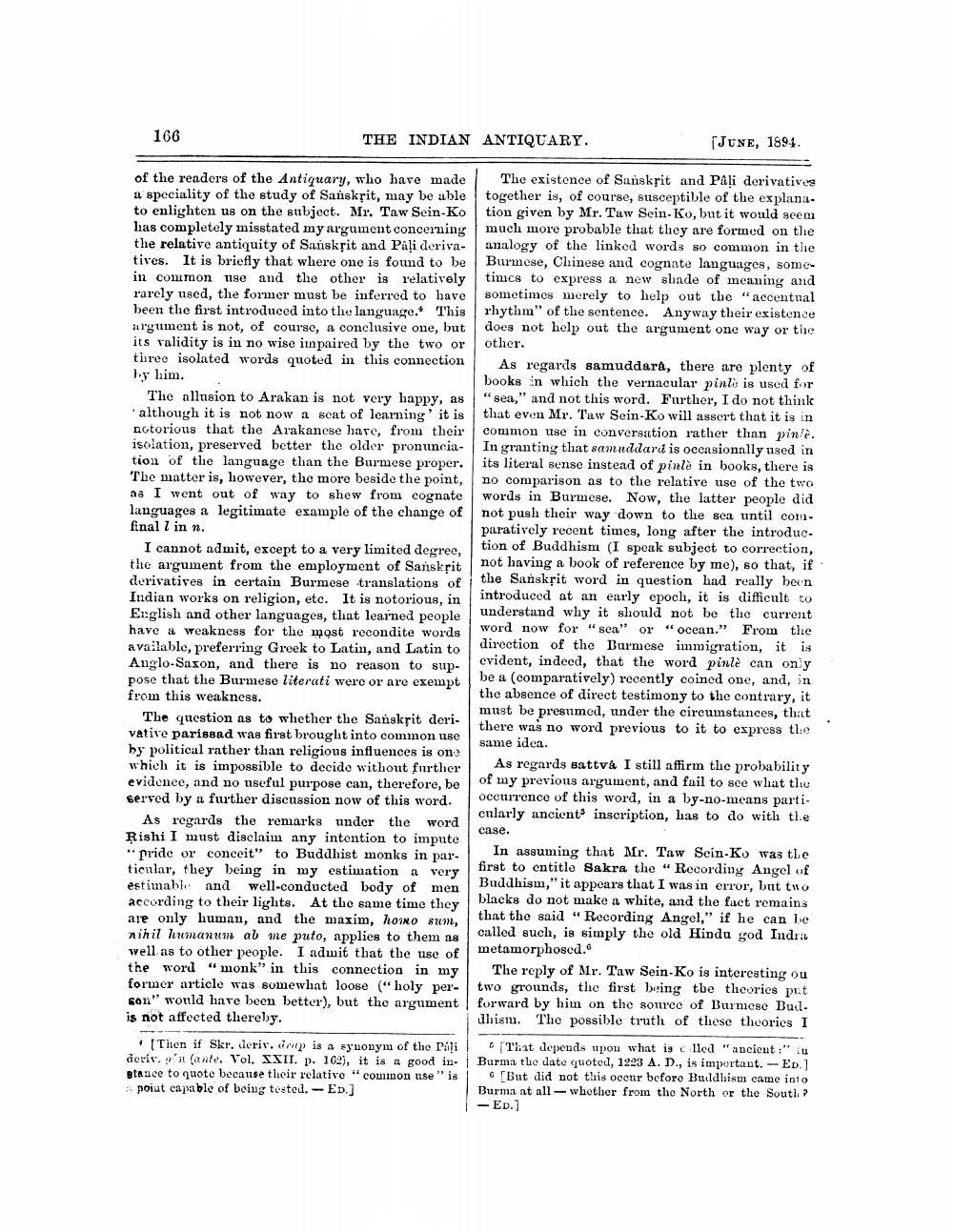________________
166
THE INDIAN ANTIQUARY.
(JUNE, 1894.
of the readers of the Antiquary, who have made The existence of Sanskrit and Pali derivatives a speciality of the study of Sansksit, may be able together is, of course, susceptible of the explana. to enlighten us on the subject. Mr. Taw Sein-Ko tion given by Mr. Taw Sein-Ko, but it would seem las completely misstated my argument concerning much more probable that they are formed on the the relative antiquity of Sanskțit and Pați deriva- analogy of the linked words so common in the tives. It is briefly that where one is found to be Burmese, Chinese and cognate languages, some in common use and the other is relatively times to express a new shade of meaning and rarely used, the former must be inferred to have sometimes merely to help out the "accentual been the first introduced into the language. This rhythm" of the sentence. Anyway their existence argument is not, of course, a conclusive one, but does not help out the argument one way or the its validity is in no wise impaired by the two or other. three isolated words quoted in this connection
As regards samuddara, there are plenty of hy lim. .
books in which the vernacular pinle is used for The allusion to Arakan is not very happy, as "sea," and not this word. Further, I do not think although it is not now a seat of learning' it is that even Mr. Taw Sein-Ko will assert that it is in actorious that the Arakanese hare, from their common use in conversation rather than pinle. isolation, preserved better the older pronuncia- In granting that samuddard is occasionally used in tion of the language than the Burmese proper. its literal sense instead of pinlè in books, there is The matter is, however, the more beside the point, no comparison as to the relative use of the two as I went out of way to shew from cognate words in Burmese. Now, the latter people did languages a legitimate example of the change of not push their way down to the sea until com. final l in n.
paratively recent times, long after the introduc. I cannot admit, except to a very limited degree, tion of Buddhism (I speak subject to correction, the argument from the employment of Sanskrit
not having a book of reference by me), so that, if derivatives in certain Burmese translations of
the Sanskrit word in question had really been Indian works on religion, etc. It is notorious, in
introduced at an early epoch, it is difficult to English and other languages, that learned people
understand why it should not be the current have # weakness for the most recondite words
word now for "sea" or "ocean." From the available, preferring Greek to Latin, and Latin to
direction of the Burmese immigration, it is Anglo-Saxon, and there is no reason to sup
evident, indeed, that the word pinle can only pose that the Burmese literati were or are exempt
be a (comparatively) recently coined one, and, in from this weakness.
the absence of direct testimony to the contrary, it
must be presumed, under the circumstances, that The question as to whether the Sanskrit deri.
there was no word previous to it to express the vative parissad was first brought into cominon 1180
same idea. by political rather than religious influences is one which it is impossible to decide without further
As regards sattvå I still affirm the probability evidence, and no useful purpose can, therefore, be
of my previous argument, and fail to see what the served by a further discussion now of this word.
occurrence of this word, in a by-no-means parti
cnlarly ancient inscription, has to do with the As regards the remarks under the word
case. Rishi I must disclaim any intention to imputo "pride or conceit" to Buddhist monks in par.
In assuming that Mr. Taw Sein-Ko was the ticular, they being in my estimation a very
first to entitlo Sakra the "Recording Angel of estimable and well-conducted body of men
Buddhism," it appears that I was in error, but two according to their lights. At the same time they
blacks do not make a white, and the fact remains ale only human, and the maxim, horno sum,
that the said “Recording Angel,” if he can le nihil loremnanum ab me puto, applies to them as
called such, is simply the old Hindu god Indra well as to other people. I admit that the use of
metamorphosed. the word "monk" in this connection in my The reply of Mr. Taw Sein-Ko is interesting ou former article was somewhat loose ("holy per- two grounds, the first being tbe theories put son" would have been better), but the argument forward by him on the source of Burmese Buil. is not affected thereby.
dhism. The possible truth of these theories I
. [Then if Skr. derir, inip is a synonym of the Pali That depends upon what is c-lled "ancient:" in deris. (ante. Vol. XXII. p. 162), it is a good in. | Burma tho dato quoted, 1223 A. D., is important. -ED. Brace to quote because their relative " cominon tuse" is! [But did not this occur boforo Buddhism came into poiut capable of being treted. -ED.]
Burma nt all-whether from the North or the South - ED.]




